This article was co-authored by Pippa Elliott, MRCVS. Dr. Elliott, BVMS, MRCVS is a veterinarian with over 30 years of experience in veterinary surgery and companion animal practice. She graduated from the University of Glasgow in 1987 with a degree in veterinary medicine and surgery. She has worked at the same animal clinic in her hometown for over 20 years.
This article has been viewed 85,723 times.
If you own a pregnant mare, you may want to know the sex of her foal before she gives birth. Ultrasonography, a visual imaging technique, is a very accurate method to determine the sex of an unborn foal.[1] Although a veterinarian will perform the ultrasound, it will be helpful for you, as your horse’s owner, to have a good understanding of how an unborn foal’s sex is determined.
Steps
Preparing to Determine the Unborn Foal's Sex
-
1Decide what you will do with the information on the foal’s sex. From a business perspective, the sex of the unborn foal can have many implications. Commonly, the sex can influence whether to keep or sell your mare.[2] [3] For example, you may decide to keep the mare if she is having a filly (female), or sell if her she is having a colt (male).[4]
- Some horse owners may also consider selling a mare’s weanling based on the sex of her unborn foal.[5]
- The sex of the unborn foal can also influence decisions concerning appraisal and insurance coverage.[6]
- Horse owners may want a filly or colt by a particular sire. For example, if a mare is pregnant with a filly by a particular sire, but the owner wants a colt, the owner may want to breed their mare to the same sire again to try for a colt.[7]
- Discuss the potential options with your veterinarian. You should decide what is best for you, whether it is from a business or personal perspective.
-
2Schedule an appointment with your veterinarian. During your mare’s pregnancy, the first window of opportunity to determine the unborn foal’s sex with nearly 100% accuracy is between day 60 and day 75. Because of this, it will be important for you to schedule an ultrasound appointment with your equine veterinarian during this timeframe.[8]
- Before scheduling the appointment, refer to your breeding records to determine the first day of your mare’s pregnancy.
- Your veterinarian may want to perform the ultrasound at their clinic. Confirm the location of the ultrasound when scheduling the appointment.
Advertisement -
3Learn the limitations of the procedure. It is very important to understand that ultrasonography will only determine the unborn foal’s sex. It should not be used to control the sex. In other words, if the unborn foal’s sex is not what you desire, you should not terminate the pregnancy and quickly re-breed your mare to try to obtain the desired sex.[9]
- Keep in mind that, by the time the unborn foal’s sex can be accurately determined by ultrasound, your mare will be too far into her gestation to re-breed her in time to have a normal foaling date the following year.[10]
Determining the Sex of the Unborn Foal
-
1Obtain the proper supplies. Your equine veterinarian will perform the ultrasound, and will thus supply the necessary instrumentation to perform the ultrasound. Supplies include an ultrasound machine, a five-megahertz transducer, and a portable viewing stand.[11] Your veterinarian may also bring a printer to print out the images.[12]
- The ultrasound machine will transmit high-frequency sound waves through the transducer. When the sound waves hit a barrier between body tissues (e.g., soft tissue and bone), they will get reflected back to the transducer and then relayed back the machine to produce a two-dimensional image (called a sonogram).[13]
- Because your mare will need to stand still during the procedure, your veterinarian may want to use fly repellent to keep away any distracting flies.[14]
-
2Use the transducer to scan the unborn foal. Your veterinarian will insert the transducer into your mare’s rectum to view the unborn foal. Before trying to determine the sex, they will first scan the unborn foal in its entirety.[15]
- Be aware that an ultrasound may reveal that the unborn foal is not alive.[16] If your veterinarian determines that the unborn foal is dead or dying, they will discuss how to handle the miscarriage.
-
3Determine the sex of the unborn foal. After scanning the entire unborn foal, your veterinarian will then look for a particular body part—the genital tubercle—to determine the sex. Although the genital tubercle is visible by ultrasound as early as day 40 to 45 of your mare’s pregnancy,[17] it will be most easily visible between days 60 and 75.
- At around day 55, the genital tubercle moves from its original position towards other body parts. It will move towards the umbilicus in colts and towards the anus in fillies—this will be most clear via ultrasound after day 60.[18]
- The tubercle will eventually develop into mature sexual organs: the penis in colts and the clitoris in fillies.[19]
-
4Observe the external genitalia. External genitalia can be observed via ultrasound around day 110 of your mare’s pregnancy.[20] Be aware, however, that external genitalia can be difficult to differentiate from surrounding soft tissue.[21] Because of this, determining sex using external genitalia is not as accurate (about 80% accuracy) as identifying the genital tubercle’s location.[22]
-
5Do not use the 'nail test.' The 'nail test' is a myth on how to determine the sex of the unborn foal. To perform the test, you would take a section of hair from the mare's tail and tie a nail to it. You would then hold the section of hair near your mare's hips.[23]
Warnings
- Do not rely on myths (the nail test, tail fuzziness) to determine the sex of the unborn foal.⧼thumbs_response⧽
- The unborn foal’s sex can be accurately determined only during the early part of your mare’s pregnancy. Beyond day 150, the unborn foal will be too large for your veterinarian to identify the genital tubercle.[29]⧼thumbs_response⧽
References
- ↑ http://www.gvequine.com.au/reproduction/ultrasound
- ↑ http://www.thehorse.com/articles/10285/equine-fetal-sex-determination
- ↑ http://www.thehorse.com/articles/12647/filly-or-colt-find-out-before-its-born
- ↑ http://www.thehorse.com/articles/12647/filly-or-colt-find-out-before-its-born
- ↑ http://www.thehorse.com/articles/12647/filly-or-colt-find-out-before-its-born
- ↑ http://www.thehorse.com/articles/10285/equine-fetal-sex-determination
- ↑ http://www.thehorse.com/articles/12647/filly-or-colt-find-out-before-its-born
- ↑ http://www.thehorse.com/articles/12647/filly-or-colt-find-out-before-its-born
- ↑ http://www.thehorse.com/articles/10285/equine-fetal-sex-determination
- ↑ http://www.thehorse.com/articles/10285/equine-fetal-sex-determination
- ↑ http://www.thehorse.com/articles/10285/equine-fetal-sex-determination
- ↑ http://www.thehorse.com/articles/10285/equine-fetal-sex-determination
- ↑ http://www.physics.utoronto.ca/~jharlow/teaching/phy138_0708/lec04/ultrasoundx.htm
- ↑ http://www.thehorse.com/articles/10285/equine-fetal-sex-determination
- ↑ http://www.thehorse.com/articles/10285/equine-fetal-sex-determination
- ↑ http://www.thehorse.com/articles/12647/filly-or-colt-find-out-before-its-born
- ↑ http://www.gvequine.com.au/reproduction/ultrasound
- ↑ http://www.thehorse.com/articles/12647/filly-or-colt-find-out-before-its-born
- ↑ http://www.thehorse.com/articles/10285/equine-fetal-sex-determination
- ↑ http://www.thehorse.com/articles/12647/filly-or-colt-find-out-before-its-born
- ↑ http://www.thehorse.com/articles/10285/equine-fetal-sex-determination
- ↑ http://www.thehorse.com/articles/12647/filly-or-colt-find-out-before-its-born
- ↑ http://www.horse-sense.org/archives/20070304134703.php
- ↑ http://www.horse-sense.org/archives/20070304134703.php
- ↑ http://www.horse-sense.org/archives/20070304134703.php
- ↑ http://www.thehorse.com/articles/10285/equine-fetal-sex-determination
- ↑ http://www.thehorse.com/articles/10285/equine-fetal-sex-determination
- ↑ http://www.thehorse.com/articles/10285/equine-fetal-sex-determination
- ↑ http://www.thehorse.com/articles/12647/filly-or-colt-find-out-before-its-born
About This Article
If you need to tell the sex of a mare’s unborn foal, schedule a visit with your veterinarian for an ultrasound. Prior to the visit, determine the first day of the mare’s pregnancy as closely as you can, then schedule the ultrasound so it falls between days 60-75 of the gestation period. If the foal is a male, the genital tubercle will be closer toward the umbilical cord, and it will be closer to the anus if the foal is a female. If the ultrasound occurs later in the pregnancy, after around 110, the veterinarian may be able to observe the foal’s external genitalia to determine its sex. Keep reading for tips from our Veterinary co-author on how the foal’s gender might influence your decision to keep the mare!
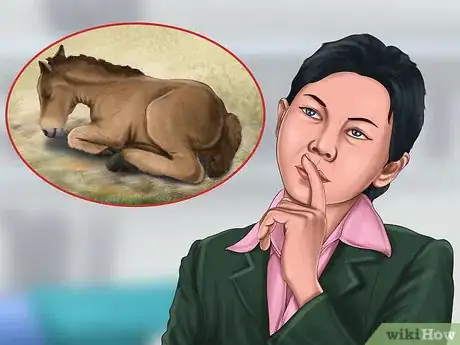

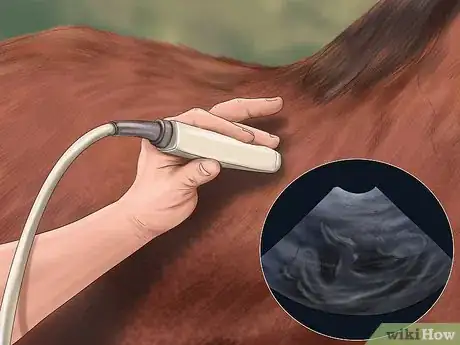

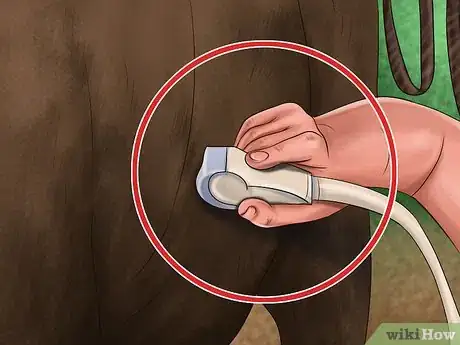
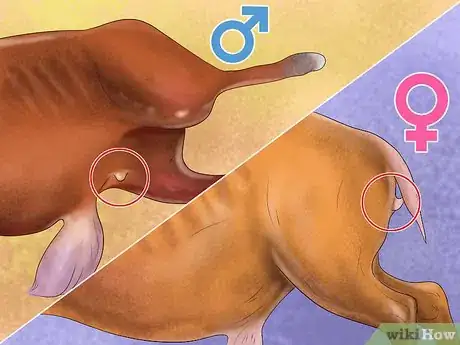

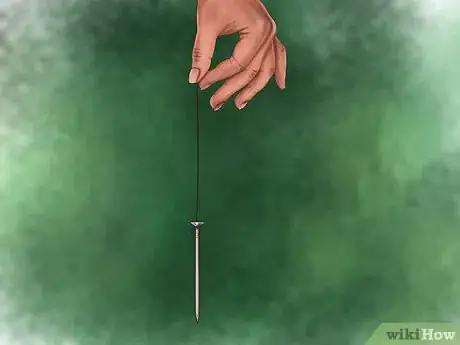





-in-Horses-Step-4-Version-2.webp)





















































